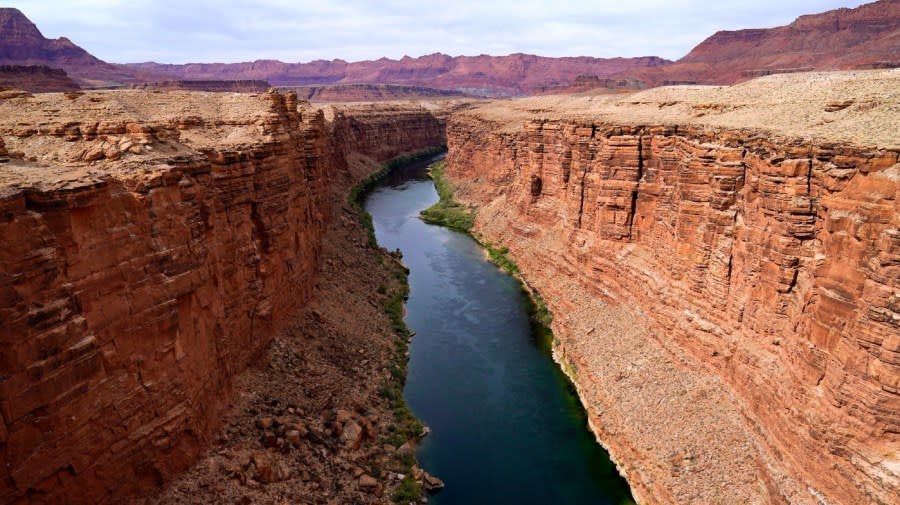Climate change may have siphoned a Lake Mead-sized sip of water from the Colorado River Basin

Scientists are holding human-induced climate change responsible for the Colorado River Basin’s loss of more than 10 trillion gallons of water — or about the entire storage capacity of Lake Mead — over the past two decades.
Without the impacts of anthropogenic warming, drought conditions would not likely have depleted reservoir levels low enough to require a first-ever federally declared water shortage, which the U.S. government instituted in 2021, the scientists determined in a new study.
The findings come at a watershed moment for the Colorado River region, where stakeholders from the federal government, the seven basin states, tribal nations and Mexico are about to renegotiate the long-term guidelines that govern the basin.
“The fact that warming removed as much water from the basin as the size of Lake Mead itself during the recent megadrought is a wakeup call to the climate change impacts we are living today,” lead author Benjamin Bass, a hydrologic modeler at the University of California, Los Angeles, said in a statement.
While previous analyses of Colorado River resources have focused on the effects of climate processes alone, this study — published in Water Resources Research — also probed how rising carbon dioxide levels have interfered with vegetation and reduced available runoff.
The scientists identified a 10.3 percent decrease in runoff amid drought conditions from 2000 to 2021 — or a cumulative volume loss of about the full capacity of Lake Mead, the basin’s largest reservoir.
The situation has been particularly dire in the usually snow-covered areas of the region, which are now losing water about twice as fast as snowless parts of the basin, according to the study.
“We were surprised to find how sensitive the basin is to warming compared to other major basins across the western U.S., and how high this sensitivity is in the relatively small area of the basin’s crucial snowpack regions,” Bass said.
The UCLA research team explored how the basin’s hydrology has changed from 1880 through 2021, using a land surface model capable of analyzing water, changes in vegetation and the response of plants to rising carbon dioxide levels.
They then employed standard data on atmospheric conditions, streamflow gauges and other factors to capture the region’s hydrology, as well as ground and satellite information to record tangible changes in vegetation.
“We had all the major players in terms of runoff’s sensitivity to climate change,” Bass said.
During the 1880–2021 period, the temperature in the Colorado River Basin warmed about 1.5 degrees Celsius (2.7 degrees Fahrenheit) because of human-induced climate change, according to the study.
This warming directly led to the 10.3 percent reduction in runoff observed by Bass and his colleagues.
But they stressed that without including the help of plants at all, present-day water loss would be closer to 13 percent — indicating the importance of accounting for vegetation changes in water modeling.
The fact that typically snow-covered areas are now hemorrhaging water so much faster than snowless regions was particular cause for concern among the scientists.
This transition, they explained, should be alarming to water managers, who rely on snowpack for an outsized contribution to the basin’s water supply. While only about a third of the basin is blanketed in snow each year, these areas are responsible for about two-thirds of the region’s total runoff, the authors warned.
Given that the original rules of the Colorado River were defined by a compact more than a century ago — on the assumption that the regional climate was stable — Bass stressed the need for a significant adjustment that considers the impacts of warming.
“Going into the future, we may get some natural variability, wet or dry swings, but this study highlights that there’s been a decreasing trend in runoff,” he said. “In the long run, that’s likely to continue if greenhouse gas emissions are not reduced.”
For the latest news, weather, sports, and streaming video, head to The Hill.

